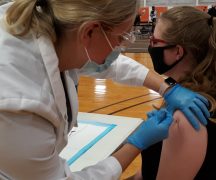One of the most celebrated holidays on the United Nations’ calendar is Sunday, when more than 150 nations will celebrate World Food Day. And Ohio State will host North America’s official session.
Former Agriculture Secretary Dan Glickman and Jocelyn Brown Hall, director of the UN’s Food and Agriculture Organization for North America, will be among the speakers.
Food security is a major problem in Ohio and the United States, with local foodbanks rationing food and worrying about having enough for the winter. Meanwhile, just over 10% of American households had to worry about where their next meal was coming from at some point in 2021, according to the U.S. Department of Agriculture. Of that group, 5.1 million households had very low food security that year, the USDA said.
Unsurprisingly, things are worse in poorer nations.
“Battered by conflict, economic crises, inequality, the climate crisis and rising food prices, today, 3.1 billion people around the world still cannot afford a healthy diet,” a World Food Day pamphlet says. “Paradoxically, two out of three people living in extreme poverty live in rural settings and mostly rely on agriculture for their livelihood. In the face of a global hunger crisis, we need to harness the power of solidarity and collective action to build a sustainable world where everyone has regular access to enough nutritious food.”
The problem is growing rapidly worse, with the pandemic and war in Ukraine — the bread basket of Europe — disrupting already-fragile lines of supply. At the same time, historic flooding in Pakistan is destroying crops, spreading diseases and endangering the lives of 10 million children, according to the United Nations International Children’s Emergency Fund, or UNICEF.
“Hunger is still on the rise and affected as many as 828 million people in 2021 — an increase of about 46 million people since 2020 and 150 million since 2019,” the Food Day pamphlet said. “The situation is similar for crisis-level acute food insecurity, or sporadic, sudden crises that limit people’s access to food in the short term to the point that their lives and livelihoods are at risk. In just two years, the number of acutely food insecure people has risen from 135 million to 193 million, and 2022 is likely to prove worse. Some 750 000 people are living in famine conditions in five countries (Afghanistan, Ethiopia, Somalia, South Sudan and Yemen) — more than five times as many as in 2020, according to the Food and Agriculture Organization) and(World Food Program) Hunger Hotspots report.”
But in an interview last month, Hall, FAO’s North America Director, said that World Food Day shouldn’t be focused only on grim realities. She said her agency is helping to bring about important changes in the U.S. and places like Guatemala. One way is by introducing “climate smart” farming practices in the countryside.
“What they’re doing is not degrading the land,” she said. “We’re introducing small, relatively affordable innovations that enable farmers to reduce the amount of water and fertilizer and produce better quality crops. That can dramatically change their lifestyle and break the cycle of poverty.”
Closer to home, FAO is working to make healthy foods more affordable, for low-income people, Hall said.
She explained that World Food Day and her organization were conceived in World War II, when famines wracked Europe and Asia. It was formally founded on Oct. 16, 1945, in Quebec City.
With the mission of tackling hunger, the group’s portfolio is vast.
“If you eat it, breathe it, wear it or drink it, our organization has something to do with it,” Hall said.
Sunday’s event will run from 1:35 p.m. to 4:30 p.m. To attend remotely, register here.





